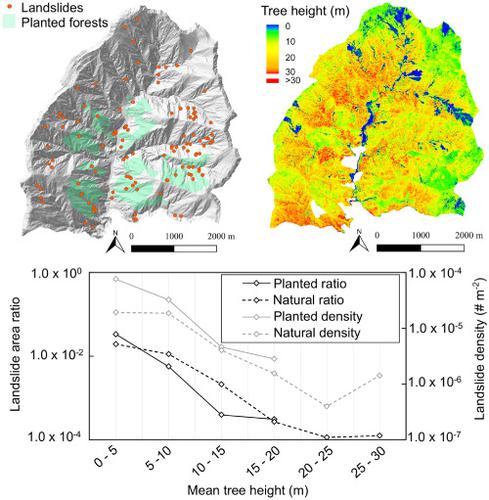当前位置:
X-MOL 学术
›
Earth Surf.Process. Land.
›
论文详情
Our official English website, www.x-mol.net, welcomes your feedback! (Note: you will need to create a separate account there.)
Relationship between tree height and landslide characteristics obtained by GIS assessment
Earth Surface Processes and Landforms ( IF 3.3 ) Pub Date : 2020-08-04 , DOI: 10.1002/esp.4964 Jamie R. Evans 1 , Fumitoshi Imaizumi 2 , Okihiro Ohsaka 2 , Shigeyuki Ogawa 2
Earth Surface Processes and Landforms ( IF 3.3 ) Pub Date : 2020-08-04 , DOI: 10.1002/esp.4964 Jamie R. Evans 1 , Fumitoshi Imaizumi 2 , Okihiro Ohsaka 2 , Shigeyuki Ogawa 2
Affiliation

|
Landslides in forested landscapes have far‐reaching implications, beyond that of just destroying the forest itself, sometimes initiating large‐scale sediment disasters. Although vegetation increases slope stability through its root network, it is hard to evaluate its contribution to slope stability over a wide area. In this study, the relationship between tree height and landslide characteristics in the Ikawa catchment, central Japan, was investigated to develop a method for evaluating the effects of forest cover on slope stability over a regional extent. Catchment‐wide tree height was obtained using airborne LiDAR point cloud data and used in conjunction with the root depth profile, measured for trees of various height by digging trenches. Root tensile strength per unit area of soil was calculated from individual root diameters and empirical power law equations on the relationship between root diameter and root tensile force in order to better understand the effect that tree height has on slope stability. Landslide density in the Ikawa catchment shows that landslides occur more frequently in forests with shorter trees, with occurrence decreasing as tree height increases. This is likely due to the stabilizing features of larger trees having a greater network of roots, which is supported by the general increase in total root area and the deeper penetration of root biomass into the soil as the height of trees surveyed increases. Landslide density was not solely affected by tree height, but also by slope gradient and plane curvature. Decreasing landslide occurrence and landslide area as tree height increases suggests that slope stability increases with tree height, while the random distribution of results when comparing landslide depth to tree height suggests that while tree height has an impact on relative slope stability, the landslide failure depth is independent of tree height, and thus controlled by other factors. © 2020 John Wiley & Sons, Ltd.
中文翻译:

GIS评估得出的树高与滑坡特征之间的关系
森林景观中的滑坡具有深远的影响,不仅破坏森林本身,有时还引发大规模的沉积物灾害。尽管植被通过其根系网络增加了边坡稳定性,但很难评估其对大范围边坡稳定性的贡献。在这项研究中,研究了日本中部伊川流域树木高度与滑坡特征之间的关系,以开发一种评估森林覆盖对区域范围内边坡稳定性影响的方法。利用机载LiDAR点云数据获得集水区全树的高度,并将其与根深剖面结合使用,通过挖沟来测量各种高度的树木。根据各个根部直径和根部直径与根部拉伸力之间关系的经验幂律方程,计算出每单位土壤的根部拉伸强度,以便更好地了解树高对边坡稳定性的影响。井川流域的滑坡密度表明,滑坡在树木较短的森林中发生的频率更高,并且随着树高的增加而减少。这可能是由于较大树木具有更大的根网络的稳定特征所致,这是由总根面积的普遍增加以及随着被调查树木的高度增加,根生物量更深地渗透到土壤中所支持的。滑坡密度不仅受树高的影响,还受坡度和平面曲率的影响。随着树高的增加,滑坡的发生和滑坡面积的减少表明边坡稳定性随树高而增加,而将滑坡深度与树高进行比较时结果的随机分布表明,虽然树高对相对边坡稳定性有影响,但滑坡破坏深度为与树高无关,因此受其他因素控制。分级为4 +©2020 John Wiley&Sons,Ltd.
更新日期:2020-08-04
中文翻译:

GIS评估得出的树高与滑坡特征之间的关系
森林景观中的滑坡具有深远的影响,不仅破坏森林本身,有时还引发大规模的沉积物灾害。尽管植被通过其根系网络增加了边坡稳定性,但很难评估其对大范围边坡稳定性的贡献。在这项研究中,研究了日本中部伊川流域树木高度与滑坡特征之间的关系,以开发一种评估森林覆盖对区域范围内边坡稳定性影响的方法。利用机载LiDAR点云数据获得集水区全树的高度,并将其与根深剖面结合使用,通过挖沟来测量各种高度的树木。根据各个根部直径和根部直径与根部拉伸力之间关系的经验幂律方程,计算出每单位土壤的根部拉伸强度,以便更好地了解树高对边坡稳定性的影响。井川流域的滑坡密度表明,滑坡在树木较短的森林中发生的频率更高,并且随着树高的增加而减少。这可能是由于较大树木具有更大的根网络的稳定特征所致,这是由总根面积的普遍增加以及随着被调查树木的高度增加,根生物量更深地渗透到土壤中所支持的。滑坡密度不仅受树高的影响,还受坡度和平面曲率的影响。随着树高的增加,滑坡的发生和滑坡面积的减少表明边坡稳定性随树高而增加,而将滑坡深度与树高进行比较时结果的随机分布表明,虽然树高对相对边坡稳定性有影响,但滑坡破坏深度为与树高无关,因此受其他因素控制。分级为4 +©2020 John Wiley&Sons,Ltd.



























 京公网安备 11010802027423号
京公网安备 11010802027423号